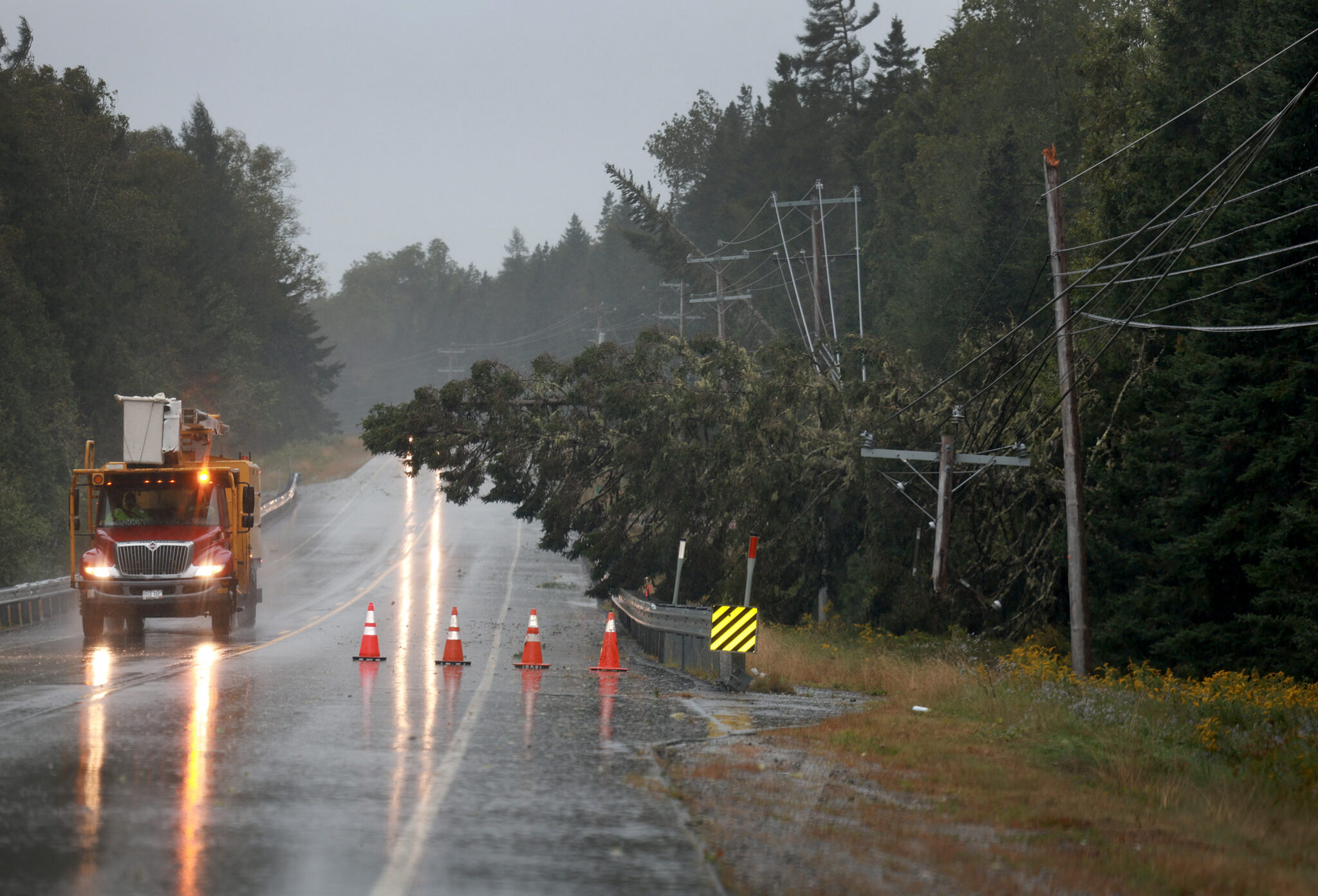Maine’s easternmost city could be a model for the nation’s renewable future
November 23, 2024

This article originally appeared on Inside Climate News, a nonprofit, non-partisan news organization that covers climate, energy and the environment. Sign up for their newsletter here.
If you trace the path of one electrical transmission line up the coast of Maine, through and around the state’s rocky outcroppings and over a long causeway, you’ll finally reach the island city of Eastport, 40 miles from the transmission line’s origin. Here, at the line’s terminus, sits the U.S.’s easternmost city and the East Coast’s deepest port, once a thriving hub of imports by sea.
Today, the city is home to about 1,300 residents, who are no strangers to the harsh winds and strong rains that give remote islands like this one their rugged character. When big storms rip through, as back-to-back nor’easters did this January, Eastport loses its sole tenuous connection to electricity from the mainland. In 2018, the city’s backup diesel generator shut down and was never replaced, leaving residents to buy their own gas generators or sit in the dark and wait out the hours until the utility could restore power.
“We’re yankees. We’re used to it. We got candles and lanterns stashed away, and we usually get a bucket of water when it looks like the power is going to go out,” said Jeanne Peacock, an Eastport city councilor and founding member of the city’s energy committee. “But it would be nice for everybody else if that didn’t happen.”
The quest to make Eastport energy resilient has put the city at the forefront of Maine’s renewable energy transition and made it a leader in energy independence work for remote communities in the state and beyond.
In 2021, the city was awarded an Energy Transitions Initiative Partnership Project grant from the Department of Energy, which funded work to develop localized energy generation and storage.
Now, a community-driven initiative is developing solar and tidal power to feed a microgrid. It would allow the island community to weather hours of outages, detached from the main electrical grid without the high costs and carbon footprint of diesel. The grant launched the feasibility studies and produced the plans for the transition that Eastport is in the middle of building out.
“This very small city on the very eastern edge of the United States is developing what would be a world-class energy facility,” said Nick Battista, the chief policy officer at the Island Institute, a Maine-based nonprofit that assisted Eastport in applying for the grant and is working to continue its implementation.
Maine among 21 states joining Biden administration in bid to modernize nation’s aging grid
As further grants and planning come through, they may adjust the existing proposal. In September, Eastport received $200,000 in its second round of funding through the DOE’s Energizing Rural Communities Prize.
This time, five other Maine coastal communities received the same grant to follow suit in starting their own islands’ electrification and resilience projects. In addition to islands like Eastport, which is connected to the mainland by a causeway, Maine has 15 unbridged coastal islands with year-round inhabitants, where people draw energy, from individual generators, larger community generators or through long cables connected to the mainland. Some of these island towns, like Isle au Haut and Islesboro, have already been working alongside Eastport to design similar resilience projects adapted to their own landscapes’ needs.
The work is picking up right as the energy world turns even more attention to the need for energy resilience on island communities. This summer, the International Energy Agency released a report describing how islands’ investment in “distributed energy sources”—which rely on microgrids and battery storage—play an important role in global decarbonization while bolstering island resilience and affordability.
The fact that Eastport is at the literal end of the line in terms of electricity transmission makes the city a perfect contender for a microgrid, said Judy Long, the communications director of Versant Power, which operates the transmission line. Because the city is so remote, there is no room for redundancies in case of outages; there are no other sources that can feed energy into the city’s existing line.
A microgrid would work as such a source. Electricity generated on the island would feed into a battery array, which would feed into the microgrid. The microgrid would remain connected to the regular electrical grid and run as normal when times are good. In the event of a storm or interruption, the microgrid could “island off” for three to four hours—which is the average duration of an outage—allowing residents to flick on their lights, run their refrigerators and heat their homes as normal.
The work requires various parts locking together: The solar, the tidal, the battery and the grid itself all must coordinate. In January, Eastport Community Solar’s 1 MW solar array will go online. It will join an existing 1.8 MW of distributed solar on Eastport. Because of the seasonal and weather variations of solar, the distributed solar alone will not be enough.
For that, the community looks to what has been one of its greatest assets throughout history: the island’s powerful tides. As water moves from the Bay of Fundy and the Atlantic into the narrow straight to Eastport’s east—which, just to keep things confusing, is called the Western Passage—it accelerates to velocities of 3 to 3.5 meters per second.
“This site off of Eastport is one of the best sites in the country for tidal power,” said Stuart Davies, the CEO of the Ocean Renewable Power Company, which develops tidal and river power turbines.
The company plans to submerge a 1-2 MW tidal power generator with long circular blades like those of a push mower in the waters of Eastport’s Western Passage by 2030.
On the other side of the island, in Cobscook Bay, the company has recently restarted testing these tide-power devices at the same site where they ran such operations in the early 2010s, before pivoting to focus on river-generated power. It was here that ORPC launched the country’s first tidal-power generator connected to the electrical grid before abandoning it after a generator problem and other complications.
Combined, the company hopes these renewed efforts can offer a proof of concept for tidal power’s promise, especially in end-of-grid and island areas like Eastport.
“Tidal energy is kind of in the forgotten asset class relative to wind and solar over the last decade,” Davies said,. He expects that the technology will finally see broader commercialization in the next 5 to 10 years.
For Versant, the power utility, as well, the Eastport project stands to be something of a testing ground for future energy technologies. It will be Versant’s first foray at incorporating a microgrid into its regular grid. The project offers an experiment in designing additional protection systems so that even if there is a fault within the small grid, it will not break down. Those lessons, Long said, would be transferable to other parts of the grid, as well as to future microgrids.
“I think the technology is in a place where it’s doable,” said Sharon Klein, a University of Maine economics professor who specializes in community energy projects. Yet she cautions that the microgrid’s success on Eastport does hang on a few open questions, like how the grid balances different energy loads across the day and how it integrates battery storage with the renewables’ input and the existing larger grid.
“I do feel hopeful for Eastport, but I do think it is still feeling pretty experimental,” Klein added.
For now, Eastport is applying and waiting for further grants to come through and fund the next stages of the project’s implementation, which the ETIPP plan outlined.
In the meantime, the community and the city’s energy committee are helping Eastport homes use less energy to begin with. Over two-thirds of the island’s homes were built in the early 1900s, so the committee has secured grant funding that helps residents identify where their homes are leaking heat and need improved insulation. They have collaborated with the local nonprofit WindowDressers to cover the cost of installing better-insulated windows.
“In my mind, all the energy things are interconnected—renewable energy, energy efficiency and the microgrid,” Klein said. “A microgrid is really great for a community because if there are power outages, a microgrid can help them not lose power to those critical loads while the rest of the grid is down. It’s even better if that microgrid can be powered by renewable energy, and you’re going to need less energy to begin with, if you’re more energy efficient.”
As someone who works with other community energy resilience projects, Klein thinks the biggest lesson from Eastport’s endeavor into building a microgrid is simply the work of navigating the bureaucratic process of applying for grants, laying out a plan and working with the community to build support for the work ahead. “There’s definitely lessons that will be able to be transferable from community to community. Even just the starting point of getting to understand the grid and your needs, that stuff can transfer.”
Some pieces, though, are specific to the unique character of the place and its people, like Eastport’s deep tides and the long journey down the causeway to the island at the end of the East.
Search
RECENT PRESS RELEASES
Related Post


